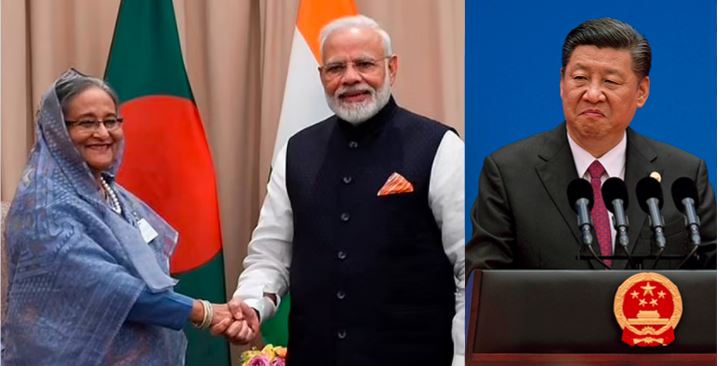The Chinese Communist Party, for the large part of 2020, took the whole world for a ride and as the countries were busy controlling the pandemic which spread from Wuhan, China continued its belligerent actions, debt trapping and wolf warrior diplomacy with least to no consequences. However, now things are changing and as countries are acting independently, China is finding it difficult to debt trap countries. In the latest, China has withdrawn funding for Belt and Road infrastructure projects in Bangladesh after the recipient country reevaluated the programs and downwardly revised their costs.
After reevaluating the infrastructure projects, Bangladesh’s railway projects which were being funded by the Chinese Belt and Road Initiative have slowed down. After the revaluation, the Bangladesh government has done cost-cutting and realising the non-viability of debt trapping Dhaka, the CCP has pulled out of these projects. The fact that Bangladesh was able to take these actions and dispel CCP’s pressure tactics, it seems obvious that its larger neighbour India has quietly pulled the strings.
The Prime Minister’s Office in Bangladesh advocated lowering rail project prices after reevaluation assessments for many infrastructure projects were released in October. The Joydebpur-Ishwardi dual-gauge double-line rail’s estimated $1.045 billion cost was to be cut by 12.91 per cent, and the Akhaura-Sylhet dual-gauge rail’s $1.272 billion budget was to be cut by 20.8 per cent. The total savings would be close to $572 million. The Chinese government responded by saying it would not support the Joydebpur-Ishwardi double-line project, and contractors for the Akhaura-Sylhet dual-gauge project refused to continue their work.
Last year, in a testament to India’s diplomatic prowess, the Bangladesh government officially cancelled the Sonadia Deep-Sea Port project. The port situated on the Bay of Bengal would have further enhanced China’s economic and strategic ambitions as the paper dragon was keen on both constructing and financing the project. Instead, Bangladesh went ahead to develop a deep-sea port at Matarbari, 25 km away from Sonadia with the help of Japan, which expected to be functional by 2025. It is pertinent to note that Japan and India share close relations and India was quite supportive of the Japanese involvement in Bangladesh and has since increased its involvement too, to shadow the Chinese presence.
Read more: India and Japan snatch Bangladesh from Xi Jinping as China gets kicked out of the port project
Only a few months ago, Indian Prime Minister Narendra Modi went to Bangladesh and met his counterpart, Sheikh Hasina. During the visit, Modi and Sheikh Hasina vowed to take connectivity between the countries to the next level, calling it ‘Connectivity for Prosperity’. Both agreed to expedite the implementation of the BBIN (Bangladesh-Bhutan-India-Nepal) Motor Vehicles Agreement to improve connectivity and simplify the movement of goods and passengers among the nations. In addition to this, during the delegation-level meeting, Modi also handed over a representational item to Bangladesh PM Sheikh Hasina as a symbol of India’s gift of 1.2 million COVID vaccine doses.
According to the joint statement, Bangladesh has also requested India for favourable consideration in the new connectivity routes proposed by Dhaka, such as allowing additional land ports of Bhadrapur-Bairagi Galgalia, Biratnagar-Jogmani and Birganj-Raxaul to be connected with Banglabandha-Fulbari and Birol-Radhikapur by road as alternative routes.
Even in March, India’s External Affairs Minister Dr. S Jaishankar met his Bangladeshi counterpart A.K. Abdul Momen and discussed Japan’s role as a third country to boost connectivity in the region. In their joint statement, Jaishankar said, “If we can get connectivity right between India and Bangladesh, I can tell u the entire logistics, the whole geo-economics of the region will change, the Bay of Bengal will look very different.”
He added, “Both of us believed that this is possible, lot of our conversation was on this specific subject, we actually feel, we should even involve 3rd countries we talked about Japan as a possibility because both of us have very good relations with Japan and Japan is involved in connectivity projects in the Bay of Bengal. I would pick connectivity as a big goal.”
All these deliberations between India and Bangladesh mean that Bangladesh has realised that depending on China will compromise Dhaka’s geopolitical manoeuvrability in the region and beyond, making it a colony of China for all practical purposes.
On the other hand, the key stipulation of Chinese funding is that the contractors should be chosen by the Chinese government rather than through an open tender procedure. The Bangladesh government will cover the costs of land purchase, local rehousing, and worker salaries and wages. The Chinese government will cover construction expenditures, which are estimated to be between 80% and 85% of the cost of the entire project. Officials noted that when a contractor is chosen without competitive bidding, costs tend to rise and the Joydebpur-Ishwardi double-line train, which will be built by a Chinese contractor, will cost $7.2 million per kilometre.
M. Humayun Kabir, president of the Bangladesh Enterprise Institute and a career diplomat, said Bangladesh needed to be cautious in taking Chinese loans since many issues remain unclear. He said, “China imposes different conditions for different countries in granting loans and expects different returns.” He added, “China’s withdrawal of funds from the projects has no geopolitical reasons, I think, but is more technical.”
Basically, it was the standard case of China’s Debt Trap Diplomacy and the fact that Bangladesh realised it, and felt comfortable as well as confident enough to confront these investments to an extent that China is willing to cancel its funding, means that India quietly pulled the strings from behind.
